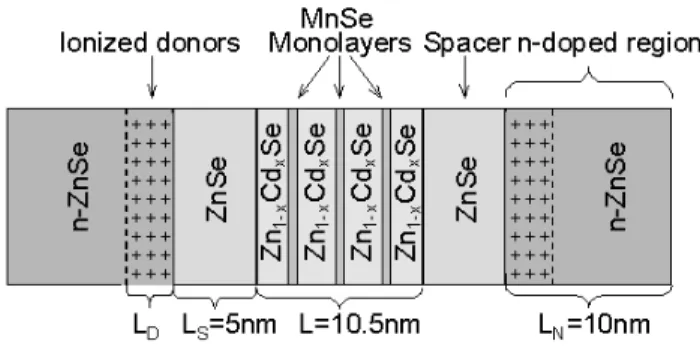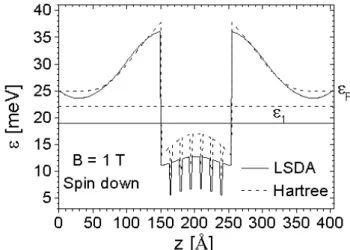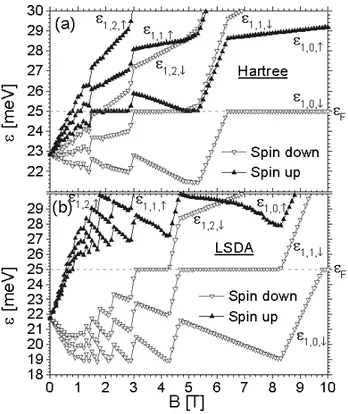Subband Struture of II-VI
Modulation-Doped Magneti Quantum Wells
Henrique J. P. Freire
and J.Carlos Egues y
Departamento deFsiaeInformatia,Instituto deFsiadeS~aoCarlos,
Universidadede S~aoPaulo,13560-970S~aoCarlos,S~aoPaulo,Brazil
Reeivedon23April,2001
Here we investigate the spin-dependent subband struture of newly-developed Mn-based
modulation-doped quantum wells. In the presene of an external magneti eld, the s-d
ex-hangeouplingbetweenarriersandloalized d eletronsoftheMnimpuritiesgivesrisetolarge
spinsplittings resulting inamagneti-elddependent subbandstruture. Withinthe framework
of the eetive-mass approximation, we self-onsistently alulate the subband strutureat zero
temperature usingDensity Funtional Theory (DFT) with a Loal SpinDensity Approximation
(LSDA).Wepresentresultsforthemagneti-elddependeneofthesubbandstrutureofshallow
ZnSe/ZnCdMnSemodulationdopedquantumwells. Ourresultsshowasigniantontributionto
theself-onsistent potentialduetotheexhange-orrelationterm. Thesealulations aretherst
stepinthestudyofavarietyofinterestingspin-dependentphenomena,e.g.,spin-resolvedtransport
andmany-bodyeetsinpolarizedtwo-dimensionaleletrongases.
Reent advanes in nanoengineering of Mn-based
semiondutor heterostrutures open up an exiting
area of researh whih ombines both magnetismand
quantum size eets. The suessful ahievement of
high-doping arrier densities in Mn-based II-VI
lay-ered ompounds [1℄ provides a new and promising
ground for researh: spin-polarized two-dimensional
magnetotransport in (semi)magneti wells. Reently,
Smorhkovaetal.[2℄reportedHall-eetmeasurements
in spin-polarized two-dimensional eletron gases in
noveln-dopeddigital-magnetiheterostrutures[3,4℄.
Here we investigate the magneti-eld
depen-dene of the spin-dependent eletroni struture of
a modulation-doped digital magneti quantum well
(QW) [2,5-7℄ using Density FuntionalTheory (DFT)
withaLoalSpinDensityApproximation(LSDA).We
onsideraDigitalMagnetiHeterostruture(DMH)[5℄
inwhihmagnetiMnatomsaredigitallyinorporated
in aplanaronguration inside the well. Inthe
pres-ene of an external magneti eld, the s-d exhange
oupling between arriersand loalized d eletronsof
the Mn impuritiesyields large spinsplittings that
ex-eed theinter-Landaulevel(LL)spaing ~!
[8℄. This
givesrisetoamagneti-elddependentsubband
stru-tureandanetspin-polarizationoftheeletrongaseven
at lowmagnetields.
Figure 1. Modulation-doped semimagneti quantumwell:
thestrutureonsistsofZnSelayerssandwihingaZnCdSe
layer ontaining digitally-inorporated MnSe monolayers.
AdjaenttotheZnSespaertherearen-dopedregions
(ele-tron reservoirs). Two depletedregions of length L
D arise
withinthen-dopedlayerasthedopingeletronsmoveinto
thewell.
Physial system. We onsider the
modulation-doped semi-magneti quantum well shown in Fig. 1.
The QW struture onsists of ZnSe layers
surround-ing a 35-monolayer (ML) ZnCdSe/MnSe
heterostru-ture with six equispaed digitally-inorporated MnSe
monolayers,denoted by6 1
2
MLafter Crookeret al.
[9℄. This notation means there are 6Mn planes with
nominal planar onentration x
p
= 1=2. Adjaent to
eahZnSe spaer,therearen-dopedregions(impurity
onentrationN
i
=1:210 17
m 3
)thatserveas
ele-tronreservoirs. Eletronsfromthen-dopedregionsll
Eletroniaddress: freireif.s.usp.br
uptheonned energylevelsof theQWthus forming
atwo-dimensionaleletrongas(2DEG)andleaving
be-hinddepletedregionsoflengthL
D
inthereservoirs.As
themagnetield ishanged,weexpetmodiations
in the self-onsistent potential and in the
orrespond-ing bandstruture due to i) magneti-eld dependent
ontributions to the onning potential and ii)
rear-rangementofeletronsintheonnedlevelsbeauseof
themagneti-eld dependentLandau-leveldegeneray
eB=h.
DFT/LSDA approah. Within Density Funtional
Theory, wesolvetheself-onsistentKohn-Sham
equa-tionsusingaLoalSpinDensityApproximationsheme
toobtainthemagnetielddependentsubband
stru-ture,modulation-dopedonningpotential,andarrier
onentration. Weonsiderthesystematzero
temper-ature and perform the alulations within the
frame-work of the eetive-mass approximation. The
domi-nantontributiontothemagnetizationomesfromthe
loalizedmomentsoftheMnions. Thesearetreatedas
aparamagneti olletionofionsby usinganeetive
Brillouinfuntion. However,wealsoonsidertheeets
of the spin density on the exhange-orrelation (XC)
term. Thisis donewithin the interpolationshemeof
Barth and Hedin[10℄ as parametrizedby Gunnarsson
andLundqvist[11℄. Sinetheenergysaleinoursystem
(tensofmeV)isthesameasthatofthealulatedXC
ontributiontotheonningpotential(upto18meV),
we expetXCto signiantlyaet theself-onsistent
subbandstruture. Thus,toassesstheroleofexhange
andorrelationintheeletronistrutureinthesenovel
geometries, we ontrast our DFT/LSDA results with
similaroneswithin theHartreeapproximation[12℄.
Results and disussions. We present results for
shallow ZnSe/ZnCdMnSemodulation-dopedQWs. By
shallow we meanthe onning potential (25 meV) is
smallenoughsothat( )10:5nmwidewellshaveonlya
fewonned subbands. Forthese geometries,n-doped
regionswithonentrationsnear10 17
m 3
provide
ar-riers that ll up all the QW levels thus serving as a
reservoirofeletrons(\reservoirhypothesis"[13℄). We
obtain the magneti-eld dependene of the subband
struture and our results show a signiant
ontribu-tiontotheself-onsistentpotentialduetotheXCterm.
Wehavealulatedtheself-onsistentpotentialprole,
eletronistrutureandthetwo-dimensionaleletroni
density for magneti elds ranging from zero to ten
tesla.
Fig. 2showsthe potentialprole, subbandenergy
and wavefuntion squared for spin-down eletrons at
B = 1T. The potential prole onsists of the
stru-turalonning potential, themagneti eld and
spin-dependent s-d exhange energy within the magneti
monolayers,theHartreeontribution, theZeeman
en-ergy, and the spin-dependent XC energy. The
result-ingself-onsistentpotentialhastheusual
modulation-Hartree energy of the onned eletrons to the
on-ning potential. We ontrast the LSDA alulation
to the Hartree one. First we note that, despite the
self-onsistentHartreeresultbeingfullyonverged,the
LSDA energy prole is not at at both ends as one
would expet. The reason for this behavior may be
that the LSDA parametrization of Gunnarsson and
Lundqvist[11℄isnotappropriatetodesribeXCatvery
low eletronidensitiessuhasthosewithin the
wave-funtion tails[theirresultsareforWigner-Seitzradius
r
s
(in units of eetiveBohr radius) within the range
1 9,whileourdatahasr
s
from20to300atthetails℄.
Nevertheless,asmostof thewavefuntion isonned
inside thewellregion, wedonotexpetthese non-at
regions to drastially aet theeletroni struture of
the system. In fat, we have tested this hypothesis
byabruptly settingtheXContribution tozeroforr
s
greater than9and wehave notfoundanysubstantial
deviationin ourresults.
Figure 2. Calulated modulation-doped potential prole,
subbandenergy"
1
andwavefuntionsquaredforspin-down
eletronsinthestrutureshowninFig. 1withintheHartree
(dashed lines)and theLSDA(solid lines)approximations.
The Fermi energy "F is set by the hemial potential of
thereservoir,arbitrarilysetto 25meV. Themaineetof
the XC ontribution in the LSDA alulation is to lower
the onningpotentialand the subbandenergy"1 for the
spin-downeletronswhenomparedtotheHartreease.
WeanlearlyseefromFig. 2thattheXC
ontribu-tionsigniantlylowerstheenergy"
1
forthespin-down
eletrons. This eet is larger for thespin-down
ele-trons than for spin-up eletrons beause the eletron
gas isspin-down polarized. Pauli's exlusionpriniple
allows(doesnotallow)aspinup (down)eletronand
themajorityspindowneletronstooverlapthusraising
(lowering)theeletrostatienergy.
In Fig. 3 we plot the rst three spin-resolved
Landau-levelfandiagramsforboththeHartree(a)and
the LSDA (b) ases. Note that the XC enhanes the
spin splittingbeauseit dereases(inreases) the spin
Fermilevel"
F
fordistintrangesofmagnetields(see
plateausat "
F
)[14℄. Inthepresentmodel,thisfollows
from the \reservoir hypothesis" whih allows for two
ompetingmehanismstoat: i) asthemagnetield
inreases, theLLs energiesalsoinrease andross the
Fermienergy,thusexpellingeletronsoutofthe
quan-tum well; ii) on the other hand, less eletrons means
lessCoulombrepulsion andtheenergytends tolower.
An equilibrium between these two mehanisms is
re-sponsible for the plateaus. Note that the pinning of
theLandaulevelinthepresentmodelisdierentfrom
the standard one used to desribe the Integer
Quan-tum HallEet(IQHE)[15℄. There,loalizedstatesin
broadenedLandaulevelsareresponsibleforthe
Fermi-levelpinning[16℄.
Figure 3. Fandiagramsfor therst threespin-down
(tri-angle down) and spin-up (triangle up) Landau levels for
both Hartree (a) and LSDA (b) alulations. Note that
the exhange-orrelation ontribution enhanes the
spin-splitting (b)and makesthe2DEGfullypolarizedatlower
magnetield(1T)thanintheHartreease(3T). The
Fermi level "
f
(dashed line) remains onstant at 25 meV
(eletronreservoir)whiletheLandaulevelsosillateasthe
spin-dependentpotentialprolehangeswiththemagneti
eld.
Oneexperimentalrelevantquantityaeted bythe
eletroni struture is the two-dimensional eletron
densityn
2D
. Atzeromagnetieldwendthatn
2D is
2:17510 11
m 2
and 1:44410 11
m 2
, respetively,
for LSDA and Hartreealulations. This onsiderable
diereneomesaboutbeauseXClowersthesubband
energies asomparedto theHartreease thus leading
to aneetiveinreaseinn .
Wehavestudiedtheself-onsistenteletroni
stru-tureofamodulation-dopedsemimagnetiquantumwell
inludingexhangeand orrelation ofeletronswithin
theDFT/LSDAsheme. Wefoundthatforshallow
ge-ometriestheexhange-orrelationontributionis
signif-ianttotheeletronistrutureasiti)lowersthe
sub-band energy of the majority spin-down eletrons and
ii)enhanesthespin-splittingthusmakingtheeletron
gasfullyspin-polarizedatlowermagnetields(1T)
thanintheHartreease(3T). Ourresultsare
prelim-inarybutdopointtotherelevaneoftheXCinshallow
ZnSesemimagnetiQWs,inontrasttoGaAssystems.
The alulations reported here are a rst step in the
study of a variety of interesting spin-dependent
phe-nomena, e.g., spin-resolved transport and many-body
eetsinspin-polarizedtwo-dimensionaleletrongases.
This work is being supported by FAPESP
(99/06868-3),Brazil. Wethank Prof. Nitin Samarth
(PennState) for suggesting this problem to us. One
of us (HJPF) aknowledges the hospitality at Prof.
Samarth'sgroupduringhisvisit.
Referenes
[1℄ I.SmorhkovaandN. Samarth,Appl.Phys.Lett.69,
1640(1996).
[2℄ I.P.Smorhkova,N.Samarth,J.M.Kikkawa,andD.
D.Awshalon,Phys.Rev.Lett.78,3571(1997).
[3℄ Longitudinal magnetotransport in Mn-based
het-erostrutureshasalso beenreentlyahieved.See,for
instane, R. Fiederling et al., Nature (London) 402,
787(1999);Y.Ohnoetal.,Nature(London)402,790
(1999);andB.T.Jonkeretal.,Phys.Rev.B62,8180
(2000).SeealsoG.Shmidtetal.,Phys.Rev.Lett.87,
227203(2001).
[4℄ For theoretial works on longitudinal spin-polarized
transport seeJ. C. Egues, Phys.Rev.Lett. 80, 4578
(1998);J.C.Egues, C.Gould,G.Rihter,andL. W.
Molenkamp,Phys.Rev.B64,195319(2001);K.Chang
and F. M. Peeters, Solid State Commun. 120, 181
(2001); and Y. Guo, J.Lu, B.Gu, and Y. Kawazoe,
Phys.Rev.B64,155312(2001).
[5℄ D. D. Awshalom and N. Samarth, J. Magn. Magn.
Mater.200,130(1999).
[6℄ R. Knobel, N. Samarth, S. A. Crooker, and D. D.
Awshalom,PhysiaE6,786(2000).
[7℄ J. J. Berry, R. Knobel, O. Ray, W. Peoples, and N.
Samarth,J.Va.Si.Tehnol.B18,1692(2000).
[8℄ J.K.Furdyna,J.Appl.Phys.64,R29(1988).
[9℄ S.A.Crookeretal.,Phys.Rev.Lett.75,505(1995).
[10℄ V.vonBarthandL.Hedin,J.Phys.C5,1629(1972).
[11℄ O.GunnarssonandB.I.Lundqvist,Phys.Rev.B13,
4274(1976).
[12℄ TheDFT/LSDAshemeaountsforXC.TheHartree
approximationisobtainedbysettingXCtozerointhis
[13℄ G.A. Bara and D. C.Tsui, Phys.Rev.B 24, 2274
(1981); A.Raymond andS.Sibari. Phys.Stat. Sol. b
183,159(1994).
[14℄ "F remains onstant at the hemial potential of the
reservoir.Notethatbeausethequantumwellis
shal-low and the donor onentration within the n-doped
regionsishigh,thisregionisneverompletelydepleted.
[15℄ K.vonKlitzing,G.Dorda,andM.Pepper,Phys.Rev.
Lett.45,494(1980).
[16℄ H. L. Stormer and D. C. Tsui, Siene 220, 1241


